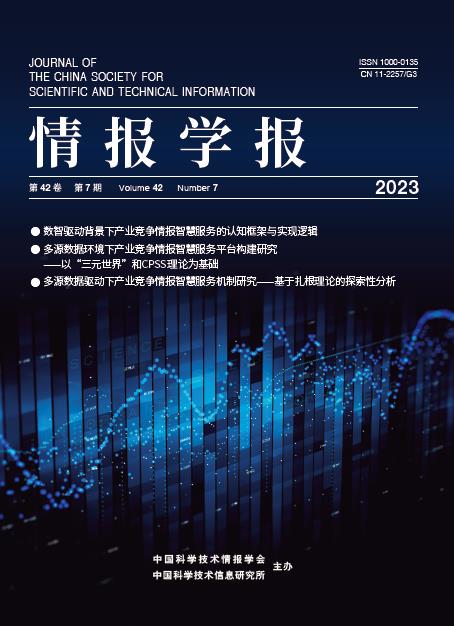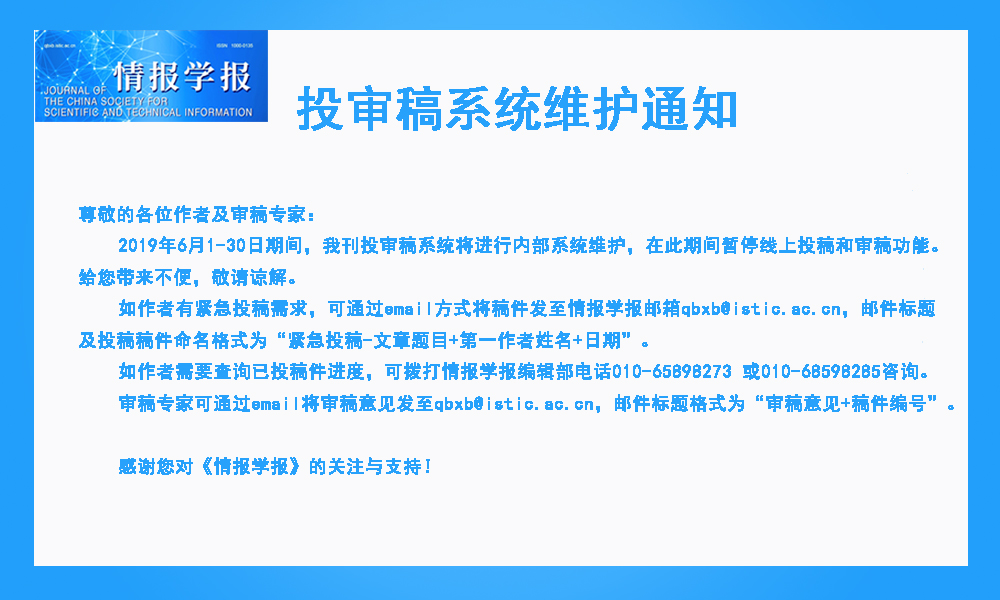 |
|
|
|
|
|
|
|
|
761 |
Cognitive Framework and Realization Logic for Industrial Competitive Intelligence Service under Digital Intelligence Background Hot! |
|
 |
Zheng Rong, Wang Xiaoyu, Gao Zhihao, Lei Yaxin |
|
|
DOI: 10.3772/j.issn.1000-0135.2023.07.001 |
|
|
To develop a healthy and orderly intelligence-enabled industry, cognition and realization of an industrial competitive intelligence service under digital intelligence background should be explored. This study presents a systematic literature review and case analysis according to the proof thinking formula of the cognition problem-analysis problem-solution problem, discusses the research progress of the industrial competitive intelligence from three service perspectives: cognition, analysis, and realization, and identifies and summarizes the new characteristics of the competitive intelligence service industry, including the intelligent interaction of service technology, problem-oriented service model, and positive ecology of service environment. The cognitive framework of the multi-dimensional integration of intelligent technology, deep transformation of service paradigm, and all-round reconstruction of service ecology, as well as the realization logic of the data fusion-knowledge mining-intelligence service will help expand the theory of industrial competitive intelligence service and provide new ideas for intelligence service practices. |
|
|
2023 Vol. 42 (7): 761-774
[Abstract]
(
352
)
HTML
(125 KB)
PDF
(3842 KB)
(
951
) |
|
|
|
775 |
Construction of Industrial Competitive Intelligence Service Platform in a Multisource Data Environment Based on the “Ternary World” and CPSS Theory Hot! |
|
 |
Gao Zhihao, Zheng Rong, Wei Mingzhu, Lei Yaxin |
|
|
DOI: 10.3772/j.issn.1000-0135.2023.07.002 |
|
|
In multisource data environments and complex information scenarios, the optimization and upgradation of industrial competitive intelligence services have become key to promoting a new round of industrial development and industrial chain optimization. The Chinese industry must urgently build a systematic competitive intelligence service platform to enable the healthy development of the industry in this era of great changes and complex international competition. This study focuses on the multisource data environment, uses the semi-structured interview method to investigate the current situation of industrial competitive intelligence service platforms, conducts a multidimensional analysis and data fusion of multisource data from the physical world, information space, and human society based on the Ternary World and cyber-physical-social systems (CPSS) modeling concepts, decomposes and reorganizes the elements of industrial competitive intelligence in terms of deconstruction, and then builds an intelligent service platform model for an industrial competitive intelligence. Finally, this study formed an industrial competitive intelligence service platform implementation path (intelligence collaborative collection and processing, multisource data cross modal and cross structure fusion, alliance chain distributed intelligence data storage, intelligence knowledge mining and discovery, and customized intelligent service) to provide integrated, intelligent, accurate, personalized and early-warning, “targeted” intelligent intelligence services for China’s industrial development. |
|
|
2023 Vol. 42 (7): 775-789
[Abstract]
(
444
)
HTML
(117 KB)
PDF
(7174 KB)
(
223
) |
|
|
|
790 |
Intelligent Service Mechanism of Industrial Competitive Intelligence Driven by Multisource Data: Exploratory Research Based on Grounded Theory Hot! |
|
 |
Zheng Rong, Wei Mingzhu, Wang Xiaoyu, Chen Yu |
|
|
DOI: 10.3772/j.issn.1000-0135.2023.07.003 |
|
|
In the context of the increasingly complex industrial competition environment globally, providing efficient and accurate competitive intelligence services has become increasingly urgent for the industrial competition and development through data empowerment, driven by multisource data and supplemented by technologies such as artificial intelligence. Therefore, exploring a systematic and multisource data-driven intelligent service mechanism for industrial competitive intelligence, creating a collaborative, systematic, and sustainable industrial competitive intelligence service environment, and ensuring the coordinated and stable operation of various service elements are urgent goals. This study adopts the semi-structured interview method to conduct in-depth interviews with working groups related to in-depth research on competitive intelligence and uses grounded theory to extract 47 initial concepts, 12 basic categories, and 4 main categories. Then, the logical relationship between categories is sorted and the function model of the intelligent service mechanism of industrial competitive intelligence driven by multisource data is finally constructed. The results indicated that the supply-and-demand coupling mechanism with demand deviation minimization - intelligence cognition maximization as the core, the collaborative guarantee mechanism with data power - intelligent technology - service ecology as the core, the linkage management mechanism with comprehensive perception - personality customization - situation guidance as the core, and the dynamic optimization mechanism with government empowerment - user energy storage - co-creation and release of energy - feedback extraction as the core form a four-in-one intelligent service mechanism system for the industrial competitive intelligence of target-core-sublimation-extension. |
|
|
2023 Vol. 42 (7): 790-800
[Abstract]
(
275
)
HTML
(103 KB)
PDF
(2027 KB)
(
660
) |
|
|
| Intelligence Theories and Methods |
|
|
801 |
Exploring the Evolution of Research Topics Based on Partial-Cumulative Citation Co-Word Network with Word2Vec Hot! |
|
 |
Cheng Xiufeng, Zou Jingjing, Ye Guanghui, Xia Lixin |
|
|
DOI: 10.3772/j.issn.1000-0135.2023.07.004 |
|
|
Discovering and clarifying the development and evolution of disciplines contribute significantly to scientific research and academic development. Targeting the single-dimension issue in regular co-word analysis, this paper proposes a subject identification and evolution analysis method based on the citation co-word network, and considers the field of “information science” as an example for empirical research. This method defines the “citation co-occurrence” association through the citation relationship, and builds a keyword network with word embedding method. Subsequently, the community detection strategy is adopted to identify field subjects, while the second discrete analysis methods are also employed to analyze the structure and trend of the subjects. The subject evolution path and trend are visualized, the results showing that the network proposed presents better topic clustering and trending visualization effect than the regular co-word networks. Indeed, the aforementioned proves that this method is an effective supplement to co-word analysis. |
|
|
2023 Vol. 42 (7): 801-815
[Abstract]
(
376
)
HTML
(261 KB)
PDF
(4577 KB)
(
737
) |
|
|
|
816 |
Recognition and Analysis of Science-Technology-Industry Interaction Patterns of Disruptive Technologies Hot! |
|
 |
Xu Haiyun, Wang Chao, Chen Liang, Xu Shuo, Yang Guancan, Zhu Lijun |
|
|
DOI: 10.3772/j.issn.1000-0135.2023.07.005 |
|
|
Disruptive technology is a “from 0 to 1” technology innovation, which can have a disruptive effect on mainstream and existing industries, form a discontinuous innovation trajectory, and ultimately promote economic and social development to produce sudden progress. Exploring the science-technology-industry interaction model of disruptive technologies has guiding significance for exploring their inherent innovation mechanisms and identifying potential disruptive technologies. First, this study adopts well-recognized disruptive technologies as the research object, and selects progressive technologies in similar fields as comparison objects. The knowledge network structure is taken as the research perspective, and we construct a three-layer network of disruptive technologies: science, technology, and industry. Finally, the overall network attribute correlation and community similarity algorithm are used to realize the correlation measurement between knowledge subnets for the identification of science-technology-industry interaction mode. Empirical analysis reveals that disruptive and incremental technology have both commonalities and differences in the correlation and interaction mode of science, technology, and industry. Finally, we present the implications of interactive pattern recognition for disruptive technology identification methods and technology-industry management. |
|
|
2023 Vol. 42 (7): 816-831
[Abstract]
(
324
)
HTML
(205 KB)
PDF
(4231 KB)
(
388
) |
|
|
| Intelligence Technology and Application |
|
|
832 |
Research on Semantic Relationship and Representation Standardization Model of Knowledge Graph Based on MDR Hot! |
|
 |
Yuan Man, Liu Mengqi, Mu Mengning |
|
|
DOI: 10.3772/j.issn.1000-0135.2023.07.006 |
|
|
A systematic review and analysis of current research and publications on knowledge graph standardization worldwide revealed that current knowledge graph processes lack standardization of the underlying semantic relation structure and representation. Therefore, based on an metadata registries (MDR) concept meta-model, this study extends semantic relation types and representations, thereby constructing a standard, extensible, and universal semantic relation meta-model for knowledge graphs for providing the necessary semantic elements and realizing the migration from traditional data semantic structure to the semantic structure of a knowledge graph. Subsequently, to standardize semantic relation representation, a standardized ontology stack was constructed for semantic knowledge graph relations under the guidance of the standardization meta-model, which provides a standard construction system for the standard representation of semantic relations of a knowledge graph based on a semantic relation structure. Finally, in the context of business requirements of down-hole operations in oil fields, the relevant semantic relations were registered, thereby achieving the standardization of semantic relations in the knowledge graph of down-hole operations in oil fields. The rationality and correctness of the proposed innovative semantic relation meta-model was verified for knowledge graphs. |
|
|
2023 Vol. 42 (7): 832-841
[Abstract]
(
311
)
HTML
(93 KB)
PDF
(2383 KB)
(
375
) |
|
|
|
842 |
Societal Impact Indicators of Research Outcomes in Humanities Based on REF Case Studies Hot! |
|
 |
Zeng Yueliang, Zheng Han, Yang Siluo |
|
|
DOI: 10.3772/j.issn.1000-0135.2023.07.007 |
|
|
While it is critical for scholars to demonstrate the academic impact of scientific research outputs, the academic community and industry have recently become increasingly concerned with the societal impact of scientific research. As a key academic discipline, the societal impact of humanities research is usually deemed as intangible and indirect. Consequently, selecting appropriate indicators for research evaluation is challenging and requires further exploration in this area. Accordingly, this study aims to explore the societal impact indicators for humanities research. Based on the Research Contribution Framework, this study used an abductive approach for analyzing 1,617 impact case studies submitted to the Arts and Humanities Panel of the Research Excellence Framework (REF) in the United Kingdom. In particular, the impact indicators embedded in the case studies were extracted through topic modeling; then, they were further mapped with the six indicators in the Research Contribution Framework (RCF). The indicators observed underlined that three emerging stages had not yet been recognized in the RCF, namely, changes in spread scope, current benefits, and forward-looking benefits. The indicator framework is more comprehensive and more in line with the characteristics of humanities research. In addition, this framework also provides a reference for the assessment mechanism optimization of societal impact of research outcomes in humanities of China. |
|
|
2023 Vol. 42 (7): 842-856
[Abstract]
(
397
)
HTML
(154 KB)
PDF
(2418 KB)
(
274
) |
|
|
| Intelligence Discipline Development and Construction |
|
|
|
| Intelligence Reviews and Comments |
|
|
870 |
A Review of Explainable Information Recommendation Hot! |
|
 |
Li Weiqing, Wang Weijun, Huang Wei, Tian Meng, Zhang Rui |
|
|
DOI: 10.3772/j.issn.1000-0135.2023.07.009 |
|
|
Explainable information recommendation can effectively improve the reliability of recommendation results and user’s trust and satisfaction, which will be an important direction of future research. Reviewing the situation and progress of research in this area can provide ideas and reference for further investigation, and promote the development of explainable recommender. By searching and investigating the literature related to explainable information recommendation at home and abroad, we deeply analyzed the status and shortcomings of research in three aspects: interpretation mechanism of explainable recommendation model, media and presentation of recommendation interpretation, and recommendation interpretation evaluation. Furthermore, we responded to the “three W (who, what, why) questions” in explainable intelligent recommender system, proposed future research directions and topics of explainable information recommendation. |
|
|
2023 Vol. 42 (7): 870-882
[Abstract]
(
389
)
HTML
(184 KB)
PDF
(1731 KB)
(
605
) |
|
|
|


